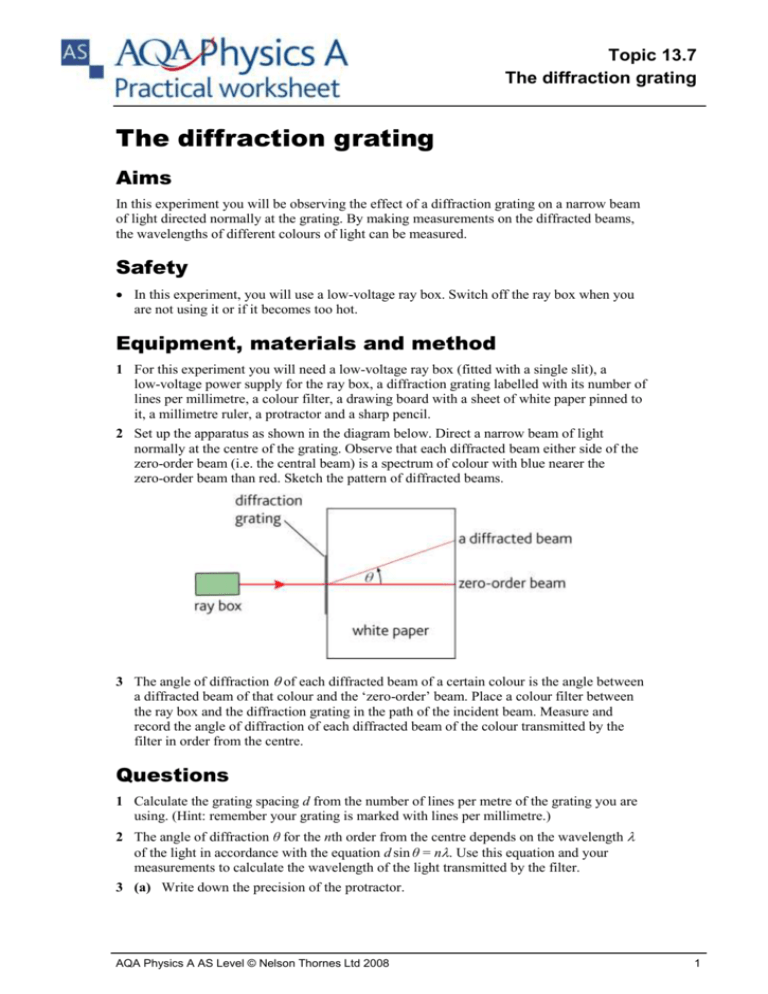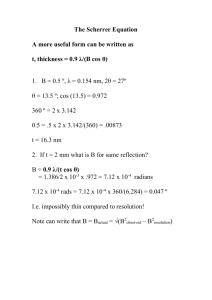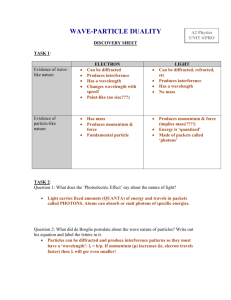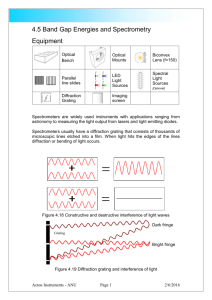AQA AS level Physics A
advertisement

Topic 13.7 13.7 The diffraction grating The diffraction grating Aims In this experiment you will be observing the effect of a diffraction grating on a narrow beam of light directed normally at the grating. By making measurements on the diffracted beams, the wavelengths of different colours of light can be measured. Safety In this experiment, you will use a low-voltage ray box. Switch off the ray box when you are not using it or if it becomes too hot. Equipment, materials and method 1 For this experiment you will need a low-voltage ray box (fitted with a single slit), a low-voltage power supply for the ray box, a diffraction grating labelled with its number of lines per millimetre, a colour filter, a drawing board with a sheet of white paper pinned to it, a millimetre ruler, a protractor and a sharp pencil. 2 Set up the apparatus as shown in the diagram below. Direct a narrow beam of light normally at the centre of the grating. Observe that each diffracted beam either side of the zero-order beam (i.e. the central beam) is a spectrum of colour with blue nearer the zero-order beam than red. Sketch the pattern of diffracted beams. 3 The angle of diffraction of each diffracted beam of a certain colour is the angle between a diffracted beam of that colour and the ‘zero-order’ beam. Place a colour filter between the ray box and the diffraction grating in the path of the incident beam. Measure and record the angle of diffraction of each diffracted beam of the colour transmitted by the filter in order from the centre. Questions 1 Calculate the grating spacing d from the number of lines per metre of the grating you are using. (Hint: remember your grating is marked with lines per millimetre.) 2 The angle of diffraction θ for the nth order from the centre depends on the wavelength of the light in accordance with the equation d sin θ = n. Use this equation and your measurements to calculate the wavelength of the light transmitted by the filter. 3 (a) Write down the precision of the protractor. AQA Physics A AS Level © Nelson Thornes Ltd 2008 1 Topic 13.7 13.7 The diffraction grating (b) Estimate the uncertainty in your calculated wavelength. Results Tabulate your measurements and show all your calculations. Discussion Discuss the accuracy of your results. Extension activity Use a spectrometer to measure the wavelengths of light from a light source that gives a line spectrum. AQA Physics A AS Level © Nelson Thornes Ltd 2008 2 Topic 13.7 13.7 The diffraction grating The diffraction grating Aims To observe the effect of a diffraction grating on a narrow beam of white light. To measure the wavelength of light of a certain colour. To observe a line spectrum and measure the wavelengths of different lines. Safety The low-voltage ray box used in this experiment may become hot. Provide a written reminder to students to switch off the ray box when not using it or if it becomes too hot. CLEAPSS information on ray boxes: Laboratory Handbook/CD-ROM section 12.16. Teaching notes 4 The main part of this experiment requires the students to observe the diffracted spectra produced by a white light source and then to use a colour filter to make measurements on light of a certain wavelength in order to determine the wavelength. Mark the direction of each order including the zero-order beam on the white paper. 5 The students could work in small groups, with each group making their measurements using filters of the same colour so the reliability of their results can be compared. This part of the investigation and the calculations should take no more than about 40 minutes. 6 Ensure that each grating is labelled with its number of lines per millimetre. 7 A spectrometer set up to observe a line spectrum could be available for each group to measure the wavelengths in the spectrum. Each group could make a measurement on a different line. This part of the investigation should take no more than 10 minutes and could be done by each group while the other groups are continuing the main investigation. 8 Remind students to use their calculators in degree mode. Answers to questions 1 , where N is the number of lines per metre. N 2 The calculated wavelength should correspond to the colour of the filter. 3 (a) Most protractors give a precision of 0.5°. (c) Calculate the wavelength for an angle of diffraction equal to the measured angle + 0.5° to give an upper limit on the wavelength. Repeat the calculation for an angle of diffraction equal to the measured angle − 0.5° to give a lower limit on the wavelength. Hence determine the uncertainty in the measured wavelength. 1 The grating spacing d (in metres) = Discussion The angle of diffraction for each order could be determined by measuring the angle from one of the beams to the corresponding beam in the same order on the other side of the zero-order beam. Dividing this measurement by two gives the angle of diffraction for that order. AQA Physics A AS Level © Nelson Thornes Ltd 2008 3 Topic 13.7 13.7 The diffraction grating The angle of diffraction could be measured more accurately using a trigonometrical method. However, each diffracted beam spreads out slightly due to the spread of wavelengths the filter transmits. Use of a trigonometrical method could give greater precision in the measurement of each diffracted angle as there is likely to be less uncertainty in the estimate of the upper and lower limit of the angle of diffraction for each diffracted beam. Practical assessment opportunities 4 PSA – use of a spectrometer 5 ISA preparation: practical task – practice in recording results, carrying out calculations written task Section A and B – discussing how to measure angles accurately Tech Notes Equipment and materials required For this experiment each student or group of students will require the following equipment: a low-voltage ray box (fitted with a single slit) a low-voltage power supply for the ray box a diffraction grating labelled with its number of lines per millimetre a colour filter and a suitable holder a drawing board with a sheet of white paper pinned to it a millimetre ruler, a protractor and a sharp pencil A spectrometer and a light source that gives a line spectrum should be set up ready for use. Safety The low-voltage ray box used in this experiment may become hot. Provide a written reminder to students to switch off the ray box when not using it or if it becomes too hot. CLEAPSS information on ray boxes: Laboratory Handbook/CD-ROM section 12.16. AQA Physics A AS Level © Nelson Thornes Ltd 2008 4








